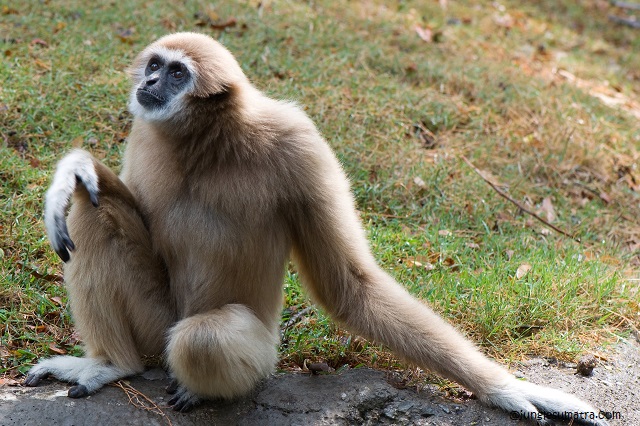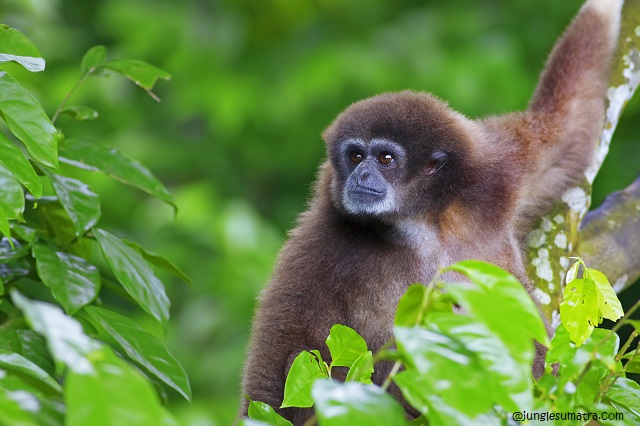![]()
The White Handed Gibbon (Hylobates lar)
This Gibbon are rare, small, slender, long-armed, tree-dwelling apes. These very acrobatic primates live in southeast Asia. Gibbons are arboreal; they spend most of their lives in trees. Because they are so dextrous while moving in the trees, almost no predators can catch them. There are nine species of gibbons, including the Siamang, which is the largest and darkest gibbon. Because of the rapid deforestation of their habitats, gibbons are an endangered species.
ANATOMY - Gibbons are very small and lightweight. They have a small, round head, very long arms (the arms are longer than the legs), and a short, slender body.
HAIR:Gibbons are covered with light-colored to very dark brown (or black) dense hair on most of their body, Some species of gibbons have a white face ring.
SENSE: Gibbons have senses very similar to ours, including hearing, sight (including color vision), smell, taste, and touch.
FACE: Gibbons have a hairless face with dark eyes, small nostrils, and jet-black skin.
HAND & FEET: Their feet have five toes, including an opposable big toe. Gibbons can grasp and carry things with both their hands and their feet. When they swing through the trees (called brachiating), they use four fingers of their hands like a hook (but they do not use the thumb for this).
SIZE: Males are about 3 ft (90 cm) long and weigh about 15 pounds (7 kg).

DIET
Gibbons are omnivores (eating plants and meat). They forage for food in the forests during the day, eating fruit (which constitutes about 75% of their diet), leaves, flowers, seeds, tree bark, and tender plant shoots. They also eat insects, spiders, bird eggs, and small birds.
Gibbons drink water, often by dipping a furry hand into the water or rubbing a hand on wet leaves, and then slurping up the water from their fur. Gibbons sometimes do this while dangling above the water from a thin tree branch.
BEHAVIOR AND SOCIAL HABITS
Groups of Gibbons: Gibbons are social animals that are active during the day (they are diurnal). They live in small, stable family groups consisting of a mated pair (a male and a female who mate for life) and their immature offspring (juveniles, gibbons less than 7 years old).
Grooming: Like other apes, gibbons groom one another (they clean the hair of a family member).
Sleeping: Unlike other apes, gibbons do not make "sleeping nests." They simply sleep (alone or with a few gibbons huddled together) in a fork between branches. They sleep sitting upright, resting on tough pads located on their rear ends (these pads are called ischial callosities).

TERRITORIALITY AND VOCALIZATION
A gibbon family has a territory of about 30 to 50 acres of old-growth rain forest. Each morning upon awakening a family group of gibbons loudly announces its presence in the forest, using a territorial hooting call and menacing gestures. This call warns other gibbons to stay out of their territory (and especially away from the local fruit trees). This noisy display takes 1/2 hour or more every morning and is usually started by the adult female. The male and female have different calls.
LOCOMOTION
Gibbons are extremely acrobatic and agile. They spend most of their life in the trees. They move by swinging gracefully from branches and vines; this is called brachiating. When they brachiate, they use four fingers of their hands like a hook (but not the thumb). They can also walk along small branches high up in the air, like tightrope walkers; they use outstretched arms to help keep their balance. Gibbons can also leap acrobatically across large gaps in the tree canopy from tree branch to tree branch; gibbons have been known to leap over 30 feet (9 m) in a single jump.
Gibbons cannot swim and avoid the water. When on the ground (which is rare), gibbons walk bipedally (on two legs).
LIFE SPAN: Gibbons live about 35-40 years.
HABITAT: Gibbons live in old growth tropical rain forests in southeast Asia.
DISTRIBUTION: The different species of gibbons live in different parts of southeast Asia, from China to the Malay peninsula, Burma, and North Sumatra


Comments (2)
event360works
03-09-2018 02:29blink-life, feedlifestarvecancer,
cheapairmax2013
13-09-2018 01:05bookmarkrelease, duzcertv,
cheapairmax2013 http://www.cheapairmax2013.com/
Post a comment
Post Tags